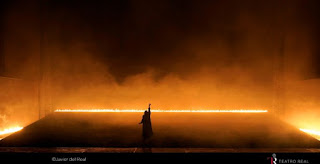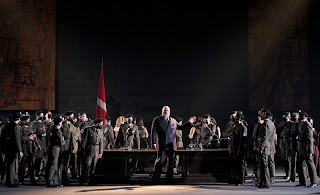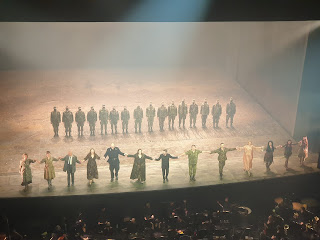In 2019, the Teatro Real embarked, for the second time after its re-opening in 1997, in a new production of Wagner's Ring, the acid test par exellence for any opera company. As usual in many opera houses, it has been given in four seasons, an opera per year. However, another opportunity to have it performed in a week - like the famed Valencia Ring by Zubin Mehta and La Fura on DVD- , as Wagner conceived it, was lost. There were rumors, that the late Gerard Mortier wanted to do it during his tenure as the Teatro Real Artistic Director, but his death prevented it.
This Madrid Ring has witnessed a twilight, too: the one of the former Pre-Covid normality. When it started in early 2019 with Rheingold, none of us could imagine that three years later our lives could experience such a turnaround one year later. In February 2020 during Walküre, when first Covid reported cases in Spain were emerging, China was in lockdown, but we still went on with our normality, not assuming chaos was closer and closer. By February 2021, the ferocious second wave was already around, and safety distance and masks were already part of our lives. Most major opera houses outside Spain were closed and offering audienceless streamings; but Teatro Real astonished the world by performing an uncut Siegfried, something unthinkable considering the new restrictions. Now, when theatres are now operating again at full capacity, but Omicron variant beating our hopes, the cycle concludes. In a way, this Ring will be remembered (as it has been being filmed and later telecasted) as the one which coped the Covid-19 and succeed.
Götterdämmerung is the final Journey of this musical epic, the most important one in Western culture. Its structure is like the complete cycle: a prologue and three acts, closer to Ancient Greek dramas. In the prologue, the Norns by spinning the thread of fate, resume the previous plot: a big conflict between gods and humans, and the tragical interactions between gods, demigods giants, dwarfs and humans. In the remaining three acts, humans pick gods' baton, and we see how they rule the world, but only to conclude the road to final destruction which the gods and other creatures had paved. Indeed humans' passions, conflicts and ambitions are not different to their predecessors in the previous operas, and we witness, as acts are going by, how the growing tension leads to the disaster. Even when the sensation of danger is constant during the whole work, Wagner wants to send us a message of hope. Gods' final doom and destruction doesn't mean the actual end of the world but a new opportunity: a new era without ambitions, curses and establishment will begin with the reconstruction once Walhalla and its intrigues are gone, and the Ring will return to its legitimate owners. Humans will reconstruct a new, better world.
The last time this masterpiece was seen in Madrid was in February-March 2004, in a production by Willy Decker, setting the plot in a theatre-inside-theatre background (still performed in Dresde), and conducted by Peter Schneider, who wasn't as accomplished as expected from such an experienced maestro. The cast was led by an unforgettable Eric Halfvarson as Hagen, but that production was sort of troubled: the tenor had to be replaced in the middle of the second performance, and the cover assuming the remaining ones. In addition, the performance of March 12, 2004 had to be cancelled because of the terrorist attack the previous day.
Eighteen years later, another vision is reaching his end in the Spanish capital. Robert Carsen's production, coming from the Cologne Opera, and called "The Eco-Ring" by some people, has set the action in a polluted, post-apocaliptic world. A vision in which pollution, and nature deterioration , intensify the conflicts and liaisons between gods, demigods, dwarfs, giants and humans in a doomed world. To Carsen, the Ring begins and concludes with pollution around, with no possibility of hope and regeneration, with no solution coming from the main characters, only to delay the unavoidable final destruction. When this production was premiered in 2000 in Cologne Opera, it was regarded as a dystopian vision. Twenty-two years later, it still seems so, but after the pandemic it also seems to have become a serious warning of what we will have to endure if we don't react.
When entering the hall, we are again greeted by that metallic, gruesome curtain we have seen in the previous journeys. The curtain rises to show the palace hall seen also in previous scenes, depicting Walhalla. Now, all the furniture seems to be packed for moving. Norns are janitors who clean the room in apathy before starting to spin the thread of fate, while a beautiful orange light, a masterful work by Manfred Voss, illuminates the stage. One of the best achievements of this Ring is the presence of real fire. And when Siegfried departs from the Walkyrie rock, a long and thin line of fire is shown, and is crossed by the hero. In Act One we return to the palace, now completely tidy, but with other occupants: now humans dwell in the former Walhalla, and have established their own fascist dictatorship. Costumes by Patrick Kimmonth re-create this: the militarized aesthetics for men, and the 1930s looks for women, approaching the action dangerously to Nazi Germany. Gunther wears Wotan's former uniform, but unlike the powerful god, he is a faint ruler, and Hagen, wearing black colours, is the mastermind. Gutrune appears as an internate student, portraying a sort of lolita. Siegfried wears always his soldier uniform.
Act Two begins with Alberich emerging from the darkness, putting his hands on Hagen's head, and then to sing to his asleep son, even moving his swivel chair around the stage while their shadows are projected to give a sinister ambiance. The second scene has a spectacular, lavish wedding ceremony, with the chorus shaking flag banners and offering a catering. Act Three is however, the most intense. In the Scene 1 we meet a familiar sight: The Rhine polluted, with junk everywhere, and the Rhinemaidens washing themselves while singing their longing song. Siegfried blows into a dirty hose instead of his horn. Soldiers sit around him to listen to his story, even sit above the dirt. The Funeral March was played with the curtain down, but lights illuminating it, in a beautiful and moving moment. The same thing happened at the end, by making Brünnhilde to sing her Inmolation scene totally alone, with the curtain down again, and singing looking to the audience, making them to participate in her final monologue. In the Finale, the curtain rises again, to show the fire and a big cloud of smoke. Then, rain falls to turn the fire off. Brünnhilde disappears and leaves the stage. Now, the complete void. This rain doesn't purify. It doesn't redeem. Now the world has been destroyed, no further life is coming. With the final note the curtain falls hiding any trace of light, closing heartbreakingly the cycle.
Pablo Heras-Casado concludes his approach to Wagner's Ring leading the Teatro Real Orchestra. The Spanish maestro has given a more than mere accompaigning rendition, but less brilliant than Siegfried last year. Götterdämmerung begins with beautiful salute to the world, but the melody which was shining and cheerful in Siegfried, now is dark, sad, melancholic. In this point the orchestra began good, with the first note played in a slow tempo, and as brass was placed (like last year) in parterre balconies, it seemed that the sound came from the depths. Acts 1 and 2 were well played, showing an improvement, despite a disastrous lose of unity in the tutti in Act 2 finale. The excellent woodwinds of the Teatro Real gave an unforgettable performance, but the strings were just correct in excerpts like Siegfried's Journey through the Rhine or Act 2 prelude. Percussion hadn't their best night, sounding like a toy. Act 3 was the best performed, with an accomplished brass in the prelude and beautiful woodwind during the Rhinemaidens's scenes. Funeral March was beautifully played, despite the troubled percussion, with an effort displayed from the orchestra, specially the brass. At the Finale, the orchestra gave a great rendition, but not as the great Funeral March. The final note was played by the beautiful woodwinds of the orchestra, prolonging the note with the slowly-fading curtain, closing the performance with the usual moving emotions when a Ring cycle ends.
The Teatro Real Chorus show again their usual vigor, specially the male voices. In Act 2 they seemed to be a bit surpassed by the orchestral volume, but they sang very well. However, the biggest effect was in Act 3, by singing the "Hoiho" calls a cappella and offstage. Deprived from any orchestral obstacle, their voices sounded powerful, menacing. As actors they were as accomplished as usual, portraying a brute, fearsome army in Act 3.
Andreas Schager as Siegfried lead the cast with his mostly stunning rendition. Indeed he not only reprised his last year great level, but also excelled it in many moments. Even when he started a bit reserved in the Prologue, during the remaining acts he showed a singing full of volume and stamina, reaching a vigorous singing in Act 2 Heilige Wehr! and during his narration in Act 3, with a great volume, even youthful tone. However, the highest tessitura is a problematic to him, specially that High C in Act 3, which he cannot cope. During the Death Scene, his singing was sung in a mild tone. Anyway, there is little doubt he is one of the most prominent heldentenors today and his Siegfried was a great one. As actor, he portrays all the hero's charisma and naughtiness.
Ricarda Merbeth reprises her Brünnhilde and like the previous year, it is clear that her voice doesn't fit in the tessitura. Her lyric-toned voice lacks the overwhelmingly dramatic part required for the role. As a result she has to force the voice. However, her dramatism on stage helps her, and as a result her high notes are benefited of this: in Act 2 and in final inmolation they sounded beautiful and imposing. In the Inmolation she gave the audience an intimate, introspective, tender rendition, specially singing sweetly the first line "Starke scheite schichtet mir dort".
Stephen Milling was an insufficient Hagen. His voice as a nice bass tone, but lacks some volume, something necessary for this role. His Hagen could be sinister but is not scary, which affects his famous scene in Act 2. His best moment was the duet with Alberich, in which his voice expressed the dreadful dream of his role.
Lauri Vasar as Gunther lacked also volume, resulting in just a correct performance. Martin Winkler has a too gutural voice for Alberich. However, this is convenient for his brief scene in this opera, in one of the best performances in the show.
Micaela Schuster as Waltraute was maybe the best performer after Schager with a powerful singing, a voice heard all over the hall, with remarkable low notes.
Amanda Majeski sang Gutrune. In the past, Majeski sang in La Clemenza di Tito at the Teatro Real in 2012. The voice sounds more dramatic than sweet and youthful, but her singing is remarkable. She was better as the Third Norn in the prologue.
The Norns and Rhinemaidens were at a correct level, but Anna Lapkovskaja was an interesting First Norn.
When the performance ended, the curtain raised again to make Merbeth to receive the complete ovation for her great final scene. Then the remaining artists took their respective bows, being Schager, Merbeth, Milling and the conductor Heras-Casado the most ovationed. There was a high occupation, and several young people were among the audience, which is really great to see. The audience of Teatro Real has changed too much since its reopening in 1997. Back to 2004, Wagner was controversial, even quite boring for some people, by judging some comments in forums and in the theatre. Now the audience enjoys his operas like a full-blown wagnerian. Indeed many of them consider themselves so.
Once again, Wagner has won over Madrid, and the Teatro Real finishes its second production of the Ring. Whenever a version of Wagner's epic ends, one can feel that a big quest is over, and turning the page over is difficult after such an experience. During these three years, the audience has kept the illusion each year, waiting for the next journey. Now, under the Wagnerian spell, we have to go on, hoping we would enjoy the next Ring production at the Teatro Real as much as we did. And hoping not much time goes by before we hear the first Rheingold notes again on its stage, because the audience has proven to love the Ring.







No hay comentarios:
Publicar un comentario